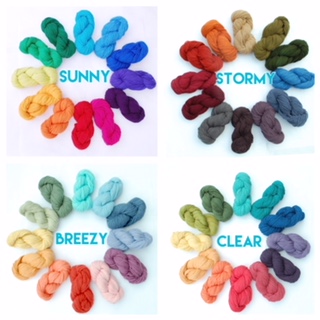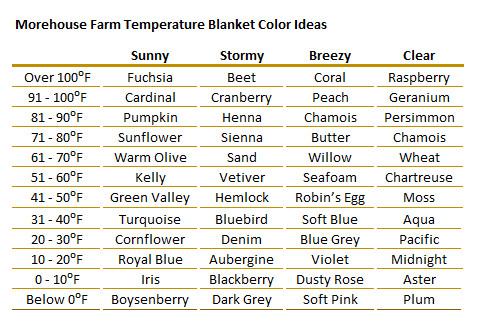Knitting Tips
Temperature Blankets and Scarves
There are many inspirations for blankets and throws, and even more for scarves – but what if you could record a whole year in one project? That’s the idea of a Temperature Blanket! By knitting one row per day with a color that corresponds to the high temperature where you live, you’ll have a brilliant display of the year.

Here’s how it works:
Start with your palette of yarns. We like 12 because that gives us a wide range of colorways, and we’re working in our 3-strand worsted weight yarn.
Choose a temperature range. For our climate here in upstate NY, we can see temperatures below zero in the winter and every once in a while it will get over 100 degrees in the summer. So we’ll make ranges of 10 degrees Fahrenheit. You can do ranges of 5 degrees if you live in a climate with less variation in temperature or if you prefer to measure in Celsius. If you live in a place with really big swings, you might want to do 15 or 20 degree increments.
Match them up! We’ve put together these four collections to help make the deciding even easier. Check out our Sunny, Stormy, Breezy, and Clear color palettes, already matched in tone.
Of course you can always build your own, too. Just put the colors you like in your cart and you’ll be able to see them side-by-side.
The Pattern:
Decide if you’d like to work in garter or stockinette stitch.
Using US #5 or #6 needles, cast on 35 stitches and work in the pattern of your choice (garter or stockinette) for 25 rows.
Measure your gauge (both number of stitches per inch and number of rows per inch). You’re aiming for 4 stitches and 5 rows to the inch.
For a 4′ (5′) wide throw, you’ll need to cast on 192 (240) stitches. (It’s only 48 stitches for a 12″-wide scarf).
Work one row each day in the pattern of your choice, using the color that corresponds to your color and temperature chart. When you finish December 31, complete the project with a stretchy bind-off. Darn in ends and block if desired.
Tips: If you’re working in Stockinette, consider slipping the first stitch on every row to minimize the edge curl.
Instead of breaking each yarn when you switch, you can leave it hanging and bring it up the side, catching it in the yarn for the next row.
Download our handy worksheet to keep track of your daily temperatures!
Weather Underground has a historical weather reference tool which you can find here if you miss a day.
What to do with all those ends? We’ve got some ideas! Click here to see them.
Optional: You may like a neutral color (like black, or natural soft white) to add a border. The amount of yarn you’ll need will depend on the final size of your blanket and the thickness of your border.
Yarn needed: 12 skeins of yarn makes a good-sized throw, but expect to need more yarn based on the variation of the weather. Where we are, there are a lot more 30-degree days than 100+ degree days! So which colors will you need the most of? We won’t know until those days happen, so your guess is as good as ours! Not to worry, though, you can always order more. There’s no need to worry about dye lots, because if you need more yarn it will end up in a different row.
 | 100% GROWN & SPUN IN AMERICA
| 100% GROWN & SPUN IN AMERICA 
